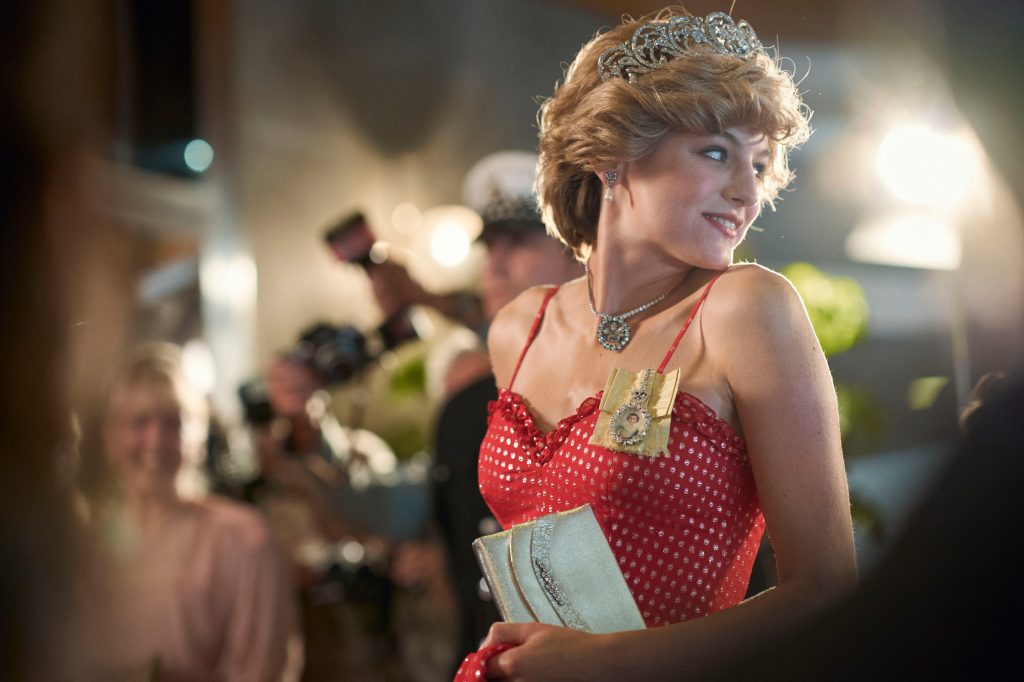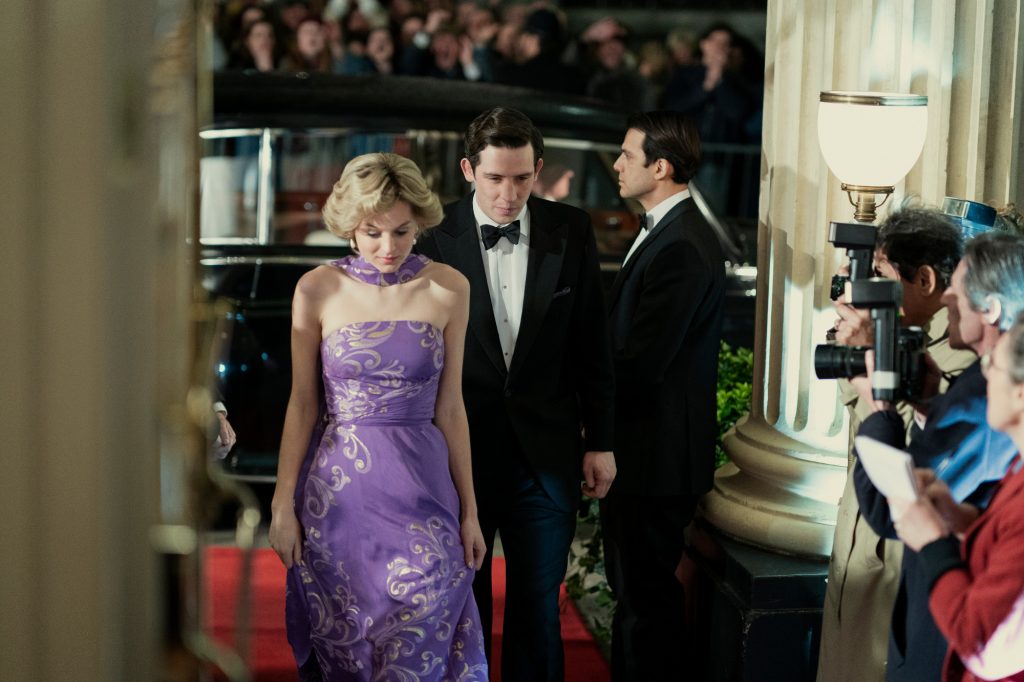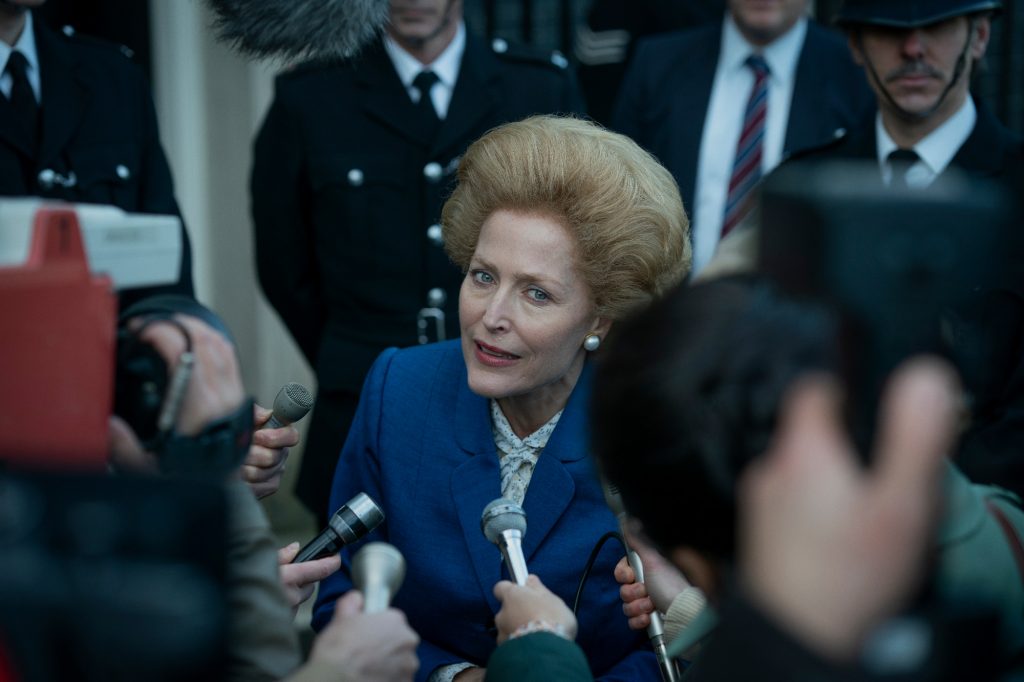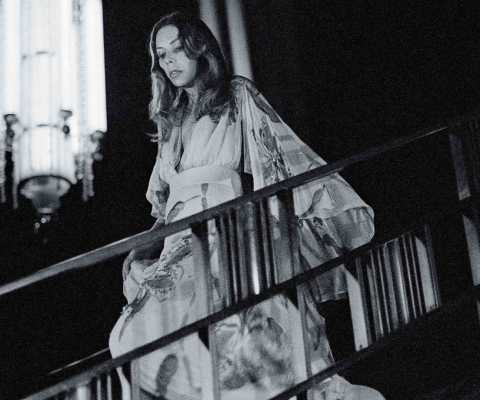If you think the Roys play a mean game of Boar on the Floor, wait until you see the Royals. The Crown season four features an epic throwdown of parlour games between the House of Windsor and Margaret Thatcher. The Iron Lady isn’t one for games. The Royals slaughter poor Margie. She just doesn’t fit into their world. The episode is dubbed “The Balmoral Test” after the bizarre hazing ritual the Royal Family puts newcomers through at their county estate. Thatcher fails the Balmoral Test spectacularly. Diana Spencer, however, aces it. This episode, the second of ten, expertly sets up the themes, tensions, and rivalries that drive the fourth season of Netflix’s royal hit. The Crown season four is a game of the hunters and the hunted.
The Crown season four easily marks the best entry in the series. The additions of the Iron Lady and England’s Rose are key ingredients. Played by Gillian Anderson and Emma Corrin, respectively, these juicy roles provide the greatest foils yet for the Royals. Nothing less than the Crown is at stake as these very different women threaten the monarchy’s traditions.

The Hunters and the Hunted
The season begins by signalling the changing times. Thatcher’s election makes her the first woman to become Prime Minister in England’s history. Queen Elizabeth II (Olivia Colman) seems both eager and apprehensive for her weekly briefings now to be with a woman. Moreover, the conservative Thatcher is a grocer’s daughter. She’s worked hard to attain her power, unlike Liz, who inherited by birth. The class inequalities underscore the tensions that develop between the Queen and Thatcher, and with Diana, as the season progresses. When the Queen invites Thatcher to Balmoral in the next episode, The Crown proves she won’t get off easy. The series portrays her as a stubborn no-nonsense workaholic who makes the Queen look like a wild time. Even Princess Margaret (Helena Bonham Carter) advises the PM to gain some perspective.
Diana, on the other hand, enters the season gradually. Charles (Josh O’Connor) needs a distraction from Camilla (Emerald Fennell). The unassuming teenage sister of his Camilla-rebound piques his interest. Their relationship, separated by eighteen years of age, moves swiftly. After just a few dates, Diana endures the Balmoral Test. Diana impresses Prince Philipp (Tobias Menzies) most strikingly after she accompanies him on a hunt for a prized stag. The striking deer becomes an effective metaphor for Diana throughout the season. Death permeates each episode of The Crown season four. From a jolting assassination to the slow kill of the esteemed stag, The Crown moves its pieces into position in the power play that will ultimately lead to Diana’s death in the next season. She’s a pawn in the Royal Family’s competing ideas of what the Crown represents in 1980.
Shy Di Gets the Guy
Princess Diana will presumably be the main attraction for many viewers this season. However, just as Diana was slow finding comfort in the spotlight, so does Corrin gradually gain confidence with the character. Take, for example, a recreation of a TV interview with Charles and Diana early in their relationship. Corrin’s performance has a certain level of self-awareness that seems feigned. Her eyes dart around the frame, overdoing it somewhat while making Diana look like a conniving tease. In other moments, Corrin almost draws inward as if Diana desperately tries to hide herself in the frame. However, if the actress initially seems awkward in the role, it’s because Diana was ill-at-ease during the courtship. After all, she was just a teenager when she started dating Charles.

The Crown is fearless in its portrayal of Diana. The season tackles Diana’s bulimia and sheer lack of life experience that made her unprepared to wear the crown. Yet as the season progresses and Diana finds her footing, winning public admiration and fuelling Charles’s resentment in the process, Corrin also displays a firm handle of the character. She truly blossoms into England’s Rose—fun, strong, and utterly magnetic.
The show is to Diana in terms of the Queen’s coldness to her and Charles’s callous rejection. Charles flaunts his relationship with Camilla openly while, in one scene that makes a viewer squirm, Camilla invites Diana on a launch date. With just a few strokes of Fennell’s marvellous performance, The Crown illustrates how Princess Di never could be best in Charles’s heart. Perhaps unexpectedly, The Crown doesn’t vilify Camilla while portraying Diana’s victimization. Camilla actually comes off remarkably fairly this season. Charles, however, does not. (Spoiler alert: Diana and Charles have some problems!)
Looking Out for #1
Just as Diana challenges Camilla for Charles’s affection, she finds a rival for attention in Margaret Thatcher. The two characters share not a scene, yet The Crown season four is a tale of competing narratives. Yet the show volleys aspects of Thatcher and Diana off one another to illustrate the Crown’s contradictions with contemporary life.
However, if Corrin gradually finds herself throughout the arc of the season, Anderson commands The Crown season four from her first appearance. Her Thatcher is top-notch. Nailing the voice, the poise, and the icy, calculating ferocity, this performance might be Anderson’s best work. Her Thatcher is wonderfully complex as a foil to Colman’s Elizabeth II.

Anderson’s unwavering authority conveys Thatcher’s thirst for power and unyielding resolve. Just take one curt exchange late in the season when the pair convene for their weekly meeting. Elizabeth II wants to clear the air after the papers report tensions in their relationship. Offering the same curt “sweep it under a rug” attitude with which she handles Charles and Diana’s collapsing relationship, Liz suggests they get down to the business of the day. “This is the business of the day, Ma’am,” Thatcher replies defiantly. In one cold exchange, Anderson evokes Thatcher’s effort to subvert the power and authority of a monarch. She is ferociously good.
The Crown vs. The Iron Lady
Comparisons between Anderson’s take on Thatcher and Meryl Streep’s performance are inevitable. However, even this die-hard Streeper calls the race a toss-up. Both interpretations are uncanny in their ability to capture Thatcher’s voice, mannerisms, and persona. However, they’re also hard to compare since The Crown inevitably limits Thatcher’s story to her time at Downing Street. Streep, however, has more work in Thatcher’s later years in which she suffered from dementia. Both are unique and worthy performances in their own rights.
Narratively, however, The Crown eclipses The Iron Lady in its portrayal of Thatcher’s politics. Whereas The Iron Lady celebrates Thatcher’s reign for breaking the glass ceiling, it simplifies her politics too much. The Falkland Islands war and her ultra-conservativism play like great wins for feminism in Phyllida Lloyd’s film. The Crown acknowledges the significance of Thatcher’s success in a male-dominated field, but it doesn’t take it at face value.
Some of the best nuances of the season, actually, illustrate how Thatcher juggles her domestic and professional roles. She still cooks dinner for her husband, Dennis, preparing meals while discussing policy. Thatcher plays mother to her ministers, too, by inviting them over and whipping up a curry when work goes overtime. In these scenes, Anderson handles a lemon wedge so delicately while Thatcher takes a battering ram to England’s social fabric. The kitchen scenes offer clips of which award shows are made. However, the stand-offs between Thatcher and Elizabeth II are the meat of the season. They give the Queen are necessary reality check, inspiring her to confront her own contradictions, particularly as a mother. Thatcher openly favours her son over her daughter, while Elizabeth remains characteristically neutral. (And, yes, Andrew makes some appearances.) As mothers, leaders, and citizens of the 20th Century, Thatcher and Elizabeth are great foils.
Bend or Break
Outside of the moments in which Streep can fully explore Thatcher’s contradictions, The Iron Lady lets her off the hook. The Crown does not and instead finds riveting drama in Thatcher’s tyranny. For example, the season delivers great suspense in the episode that deals with South Africa’s apartheid. Thatcher refuses to accommodate the Queen’s desire for the commonwealth to place sanctions on South Africa. The PM holds to her guns as Elizabeth and company seek compromises.
Round after round sees Thatcher disapprovingly copyedit their proposals, rejecting successive synonyms for “sanctions.” Anderson peruses each draft with prickly relish, wielding a pencil like surgeons do scalpels. Underlying Thatcher’s stubbornness is her belief in “looking out for number one.” She does not attempt to hide that she feels she earned how power. To her, Queen represents an outdated system that limits her right to rule. One hardly expects Thatcher to be an effective tool with which The Crown considers the relevance of the monarchy, yet it proves provocatively useful.

This rivalry echoes the scene that closes the third episode of The Crown season four. Elizabeth lunches her mother (a wonderfully crank Marion Bailey), Princess Margaret, and Princess Anne (Erin Doherty). Wondering what may happen to young Diana, the Queen mum says she’ll bend to Charles’s infatuation with Camilla. Elizabeth, somewhat naively, asks what happens if Diana doesn’t bend. “She breaks,” replies Margaret pointedly just as Anne snaps a breadstick. The duelling storylines see both Thatcher and Diana navigating bend-or-break relationships with the Crown. Particularly with Thatcher, however, does The Crown thrill with a bend-or-break tit-for-tat.
Colman Still Wears the Crown
Colman remains resolutely strong opposite Anderson. With her second season as Elizabeth II, Colman inhabits the role with a take that surprises and surpasses Claire Foy. (Foy makes a brief appearance in a flashback this season.) Colman embraces Elizabeth’s contractions this season and brings them to the forefront. One especially fine episode speculates about what transpired when Michael Fagan broke into Buckingham Palace in 1982. Colman makes Elizabeth both humble and grand as she offers an empathetic ear to her subject. As Fagan complains about Thatcher’s destruction of social services, The Crown portrays Elizabeth as pragmatically considerate. As with Anderson’s take on Thatcher, Colman’s Elizabeth acknowledges the Queen’s stronger traits, while suggesting she’s somewhat anachronistic. The Crown season four doesn’t call for an end to the monarchy but tackles the Royal family’s relevance from all angles. It suggests that the Crown, too, must bend and modernise or else it breaks.

This tension echoes throughout the subplots that develop with Charles, Anne, and especially Margaret. Bonham Carter once again proves a highlight of the season with her sad yet saucy turn as Princess Margaret. The Crown season four gives Margaret more to do even as her role among the Royals dwindles. From health scares to seeing her own depression reflected in the inevitable tragedy of Charles and Diana’s relationship, Margaret is perhaps the voice of reason this season. Like Colman, Bonham Carter’s comfort with the character shows with the new layers she reveals in each episode. Each episode of the season improves upon its successor as the characters become more human. Unlike the first three seasons, The Crown season four is not as cold in its portrayal of the Royal Family.
The Crown Season Four Is the Series at Its Best
With delectable takes on some of the 20th Century’s most prominent figures and a refreshingly mature consideration of love and life, The Crown season four is peak television. Once again, all production values are top notch, ensuring The Crown remains one of the best looking shows on TV. One notable improvement, however, is the editing and quickened pacing, which keeps the drama lively and consistently engaging. (I often fell asleep during episodes of the Claire Foy years, I’ll admit.) The only drawback is that they limited this meaty chapter in Elizabeth II’s reign to a single season. Similarly, one downside to this season of The Crown, really, is the realization that new faces will appear next year. When acting royalty makes the show more thrilling and substantive than ever, it’s bittersweet to see Colman, Bonham Carter, and company end their runs on such high notes. But if any season conveys how one must know when to pass the crown, this is it.
The Crown Season Four debuts on Netflix November 15.






Comments